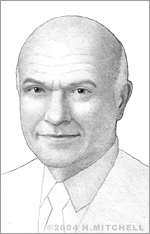Harry Coover
The incredibly stable adhesive known as Super Glue ™ was invented by accident in 1942 by Dr. Harry Coover. Today the substance is somewhat of a household necessity, with uses ranging from simple woodworking and appliance repair to industrial binding and medical applications.
Born in Newark, Delaware on March 6, 1919, Coover received his BS from Hobart College and continued his studies at Cornell University, where he earned an MS in Chemistry in 1942 and a PhD in 1944. Shortly thereafter, he began working for Eastman-Kodak’s chemical division in Rochester, New York.
During World War II, Coover was part of a team conducting research with chemicals known as cyanoacrylates in an effort to find a way to make a clear plastic that could be used for precision gunsights for soldiers. While working with the chemicals, the researchers discovered that they were extremely sticky, and this property made them very difficult to work with. Moisture causes the chemicals to polymerize, and since virtually all objects have a thin layer of moisture on them, bonding would occur in virtually every testing instance. They rejected cyanoacrylates as a feasible option and moved on with their research.
Six years later, in 1951, Coover was transferred to Kodak’s chemical plant in Kingsport, Tennessee. That’s when he re-discovered the cyanoacrylates and recognized new potential in them. He had been overseeing the work of a group of Kodak chemists who were researching heat-resistant polymers for jet airplane canopies. They tested cyanoacrylate monomers, and this time, Coover realized these sticky adhesives had unique properties in that they required no heat or pressure to bond. He and his team tried the substance on various items in the lab, and each time, the items became permanently bonded together.
Coover and his employer knew they were on to something. Coover received patent number 2,768,109 for his “Alcohol-Catalyzed Cyanoacrylate Adhesive Compositions/Superglue” and began refining the product for commercialization. His company packaged the adhesive as “Eastman 910” and began marketing it in 1958. Later, it became known as "Super Glue," and Coover became somewhat of a celebrity, appearing on television in the show “I've Got a Secret," where he lifted the host, Garry Moore, off the ground using a single drop of the substance. He also appeared in a TV commercial for the product.
During the Vietnam War, it became apparent that cyanoacrylates could be used to treat war wounds. Field surgeons began using the substance by spraying it over open wounds, which stopped bleeding instantly and allowed hurt soldiers to be transported to medical facilities for conventional treatment. This saved many lives during the war and led to the FDA's eventual approval of cyanoacrylates for certain medical uses. Some of these include rejoining veins and arteries during surgery, sealing bleeding ulcers, punctures, or lesions, stopping uncontrollable bleeding of some soft organs, and use during dental surgery.
Over the course of his career, Coover was awarded more than 460 patents, wrote at least 60 papers, and was responsible for many advances in his field, in areas ranging from graft polymerization to olefin polymerization and organophosphorus chemistry. After Coover retired as Vice President of Eastman Kodak and Director of Research and Development and New Venture Management at Eastman Chemical Division, he formed his own consulting firm for a time before being named president of new business development for Loctite Corporation in Newington, Connecticut in 1985. From there, he moved to the board of Reilly Industries in Indianapolis for nine years, while continuing to run his consulting business until his retirement in 2004.
Coover’s numerous awards include the Industrial Research Institute Medal Achievement Award, the Maurice Holland Award, the ACS Earl B. Barnes Award, and the AIC Chemical Pioneers Award. In 2004, he was inducted into the National Inventor's Hall of Fame. He received 260 patents before his death on March 26, 2011.


